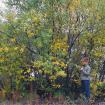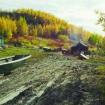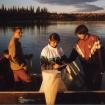Plants
Filter by categories
Over thousands of years, the Gwich’in have used a variety of trees, shrubs and berries for food, medicine, shelter and tools. Knowledge of this plant use has seriously declined in recent years.
In 1997, GSCI began work with Gwich’in elders on an ethnobotany project to record the use of this traditional knowledge in partnership with the Aurora Research Institute (ARI). The results of this research are available in a joint publication called “Gwich’in Ethnobotany: Plants Used by the Gwich’in for Food, Medicine, Shelter and Tools” by Alestine Andre and Alan Fehr.
The book highlights the use of 32 plants and 3 types of rocks and minerals. Information includes the Gwich'in names for these plants (in both the Gwichya Gwich'in and Teetł’it Gwich'in dialects), where they are found, and how they can be used. Several recipes for making medicine and preparing food are also included. Black and white and colour photographs illustrate the text.
Information from this book and a Master’s thesis by Alestine Andre (2006) called, Nan t’aih nakwits'inahtsìh (The Land Gives Us Strength) have been used to create our Gwich’in ethnobotany database. This database contains cultural knowledge about 43 plants traditionally used by the Gwich’in and is searchable by plant types and uses. You can click on any of the categories to the left to filter the records, or click on “By Type” or “By Uses” above to bring up all categories.
Please note that the plant information provided in this website is NOT a medical guide and must not be used for medical advice or self-medication. DO NOT USE any parts of a plant if you are not certain about the plant’s identity or its medicinal use. Please seek the advice of a local medicine plant specialist for plant information.
Gwich’in Plant Specialists – Ruth Welsh & Alestine Andre biographies
As food
The picking time for this plant lasts only about two weeks. The rhubarb plant is ready to eat in mid-June when it is about 20 to 25 centimeters tall (eight...
This lichen grows in large mats in spruce forests, where it is often eaten by caribou. According to Alfred Semple, Lazarus Sittichinli said it takes a long time to grow. He also told Alfred...
As food
Spruce gum, dzèh kwan' (G) dzih drinh' (T), is the hard, older kind of tree sap or pitch, with a red or rose colour. It can be picked year round from the trees...











